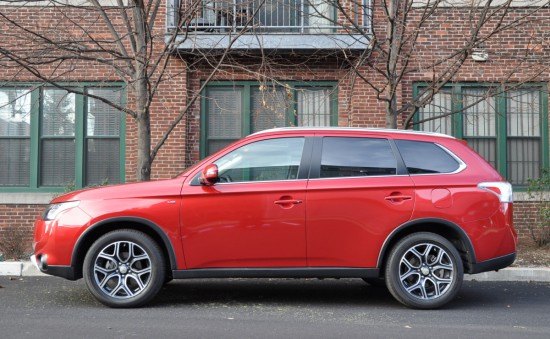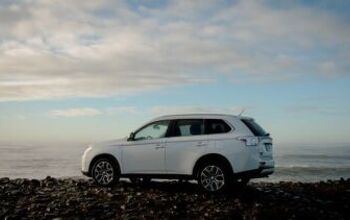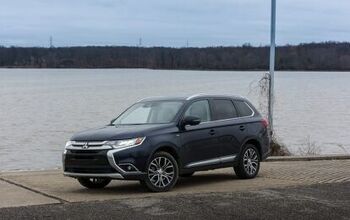Capsule Review: 2015 Mitsubishi Outlander 3.0 GT S-AWC

To say that Mitsubishi has been struggling on the North American market would be an understatement. Long gone are the days of the capable Montero, hot-selling Galant, and the exotic 3000GT. For years the Outlander Sport has been the company’s bread winner and the Lancer Evolution its only icon. In order to jumpstart its sales, in 2014 Mitsubishi dove deep into the highest volume markets with the introduction of the inexpensive Mirage and the third generation of its three-row CUV, the Outlander.
It has been said many times over that there is no such thing as a bad modern car on the North American market. Or may be there are, I don’t know anymore. The truth is that a purchase of any new car will result in a product that is safe and one that will provide years of reliable service. The new Outlander is probably not an exception, as it is a reasonably priced vehicle with a 5-year warranty and good crash test results. The question is, is it a good vehicle?
From the driver’s perspective, the dash layout is simple and rather similar to other vehicles in its class; two big gauges with a screen in-between, infotainment system with a bigger screen, two knobs and some buttons, and simple HVAC controls below. Unfortunately that middle screen does not display much information, the big screen has some small font, the Rockford-Fosgate system does not like to stream the Pandora app from my iPhone as it kept defaulting to the music stored on the phone, and there are no separate climate controls for the rear of the vehicle. Other frequently used buttons, such as the power hatch and display change button for gauge cluster screen are obscured by the steering wheel. Furthermore, the power windows, door locks, and mirror buttons are poorly illuminated and difficult to use at night.
Taking your eyes up from the dash and its mismatched piano-black and wood plastic trim, the visibility is good in all directions, certainly better than average. This is probably thanks to Mitsubishi’s liberal use of high strength steel. The Outlander is also a smaller vehicle than other three-row CUVs in just about every dimension, making it easy to maneuver. That smaller size and the use of that high strength steel translates into significantly lower curb weight than other three-row CUVs, and similar to that of many smaller CUVs, such as the Honda CR-V.
Seats are covered with a mix of fabric and hard leather. Front seats are and generally comfortable, heated, but only the driver’s seat is powered. The middle row has less legroom than other comparable vehicles and the rear doors do not open as wide or are as big, making getting kids into their seats more challenging for already tired parents. The biggest problem is with the third row seats, however, which have hardly any legroom when middle row in its native position, slid all the way to the back. Sliding the middle row forward give third row passengers more legroom, but at the expense of comfort of the people sitting in the middle row. The cargo area is also smallest in class no matter which seats are folded down and there are no visible HVAC vents anywhere in the back.
Lower Outlander models come with a four cylinder engine, but this GT model came with Mitsubishi’s 6B31 which has been around for some time. The 60-degree SOHC 24-valve 3.0-liter V6 engine is port-injected with variable cam timing and is rated at 224hp and 215lb-ft of torque, the least in its class. It is matched up to a six-speed automatic transmission and Super All-Wheel Control (S-AWC®) all-wheel drive system. This combination is rated for 20mpg in the city and 28mpg on the highway. In my leisurely mixed city/highway/mountain driving I observed 24mpg, which is very good for a three-row CUV.
My driving was leisurely because the Outlander never seems to be in the hurry. The transmission is conservatively programmed to always be in the lowest gear possible, which I found especially annoying in the mountains of Vermont, both on the way up and down. There are four transmission modes; eco, snow, lock, and normal. I have only used the normal mode, supplemented by the paddle shifters in the mountains. The engine does have plenty of power to move the Outlander, but requires a lot of motivation from your right foot.
There are many new car buyers for whom nothing matters more than the bottom line. The base Outlander ES starts at $23,195. The reviewed GT model starts at $28,195. The GT Touring Package, which includes nav system, lane departure warning, forward collision migration, sunroof, leather, power tailgate, and premium audio costs $6100. With $850 destination charge, the total comes to $35,145. A quick look at TrueCar shows that actual selling price is few grand lower.
The three-row CUV market is one of the most competitive in the industry and any company with limited resources will have difficulties offering the best vehicles. It is unfortunate that in the world of good cars, there have to be some that relatively aren’t. What frustrated me the most about this vehicle was that it could have been better with some engineering changes that would have minimum impact on overall engineering costs. While the Outlander isn’t perfect it does have some good things going for it, such as five-star overall score on NHTSA crash tests, 5-year/60,000 mile warranty with 10-year/100,000 miles for the powertrain, and the price.
Kamil Kaluski is the East Coast Editor for Hooniverse.com. His ramblings on Eastern European cars, $500 racers, and other miscellaneous automotive stuff can be found there.
Mitsubishi Motors North America, Inc. provided the vehicle for this review.

More by Kamil Kaluski
Latest Car Reviews
Read moreLatest Product Reviews
Read moreRecent Comments
- W Conrad I'm not afraid of them, but they aren't needed for everyone or everywhere. Long haul and highway driving sure, but in the city, nope.
- Jalop1991 In a manner similar to PHEV being the correct answer, I declare RPVs to be the correct answer here.We're doing it with certain aircraft; why not with cars on the ground, using hardware and tools like Telsa's "FSD" or GM's "SuperCruise" as the base?Take the local Uber driver out of the car, and put him in a professional centralized environment from where he drives me around. The system and the individual car can have awareness as well as gates, but he's responsible for the driving.Put the tech into my car, and let me buy it as needed. I need someone else to drive me home; hit the button and voila, I've hired a driver for the moment. I don't want to drive 11 hours to my vacation spot; hire the remote pilot for that. When I get there, I have my car and he's still at his normal location, piloting cars for other people.The system would allow for driver rest period, like what's required for truckers, so I might end up with multiple people driving me to the coast. I don't care. And they don't have to be physically with me, therefore they can be way cheaper.Charge taxi-type per-mile rates. For long drives, offer per-trip rates. Offer subscriptions, including miles/hours. Whatever.(And for grins, dress the remote pilots all as Johnnie.)Start this out with big rigs. Take the trucker away from the long haul driving, and let him be there for emergencies and the short haul parts of the trip.And in a manner similar to PHEVs being discredited, I fully expect to be razzed for this brilliant idea (not unlike how Alan Kay wasn't recognized until many many years later for his Dynabook vision).
- B-BodyBuick84 Not afraid of AV's as I highly doubt they will ever be %100 viable for our roads. Stop-and-go downtown city or rush hour highway traffic? I can see that, but otherwise there's simply too many variables. Bad weather conditions, faded road lines or markings, reflective surfaces with glare, etc. There's also the issue of cultural norms. About a decade ago there was actually an online test called 'The Morality Machine' one could do online where you were in control of an AV and choose what action to take when a crash was inevitable. I think something like 2.5 million people across the world participated? For example, do you hit and most likely kill the elderly couple strolling across the crosswalk or crash the vehicle into a cement barrier and almost certainly cause the death of the vehicle occupants? What if it's a parent and child? In N. America 98% of people choose to hit the elderly couple and save themselves while in Asia, the exact opposite happened where 98% choose to hit the parent and child. Why? Cultural differences. Asia puts a lot of emphasis on respecting their elderly while N. America has a culture of 'save/ protect the children'. Are these AV's going to respect that culture? Is a VW Jetta or Buick Envision AV going to have different programming depending on whether it's sold in Canada or Taiwan? how's that going to effect legislation and legal battles when a crash inevitibly does happen? These are the true barriers to mass AV adoption, and in the 10 years since that test came out, there has been zero answers or progress on this matter. So no, I'm not afraid of AV's simply because with the exception of a few specific situations, most avenues are going to prove to be a dead-end for automakers.
- Mike Bradley Autonomous cars were developed in Silicon Valley. For new products there, the standard business plan is to put a barely-functioning product on the market right away and wait for the early-adopter customers to find the flaws. That's exactly what's happened. Detroit's plan is pretty much the opposite, but Detroit isn't developing this product. That's why dealers, for instance, haven't been trained in the cars.
- Dartman https://apnews.com/article/artificial-intelligence-fighter-jets-air-force-6a1100c96a73ca9b7f41cbd6a2753fdaAutonomous/Ai is here now. The question is implementation and acceptance.







































Comments
Join the conversation
While I'm certain that there are a few people that purchase Mitsubishi products because they truly like them over competitors, to me, they fall into that bottom-feeder category of IATICA or 'It's All That I Could Afford' based mainly on generous, low interest rates offered to those with less than stellar credit ratings. A lot of Dodge, Nissan, and GM stuff would qualify, as well. In fact, one of the best examples of IATICA was the old Cavalier, along with it's successor, the Cobalt. I doubt anyone would have bought either of those cars if they could have afforded something else.
This thing is sold as a Plugin Hybrid Electric Vehicle over here. It gets 30 km's on batteries. It's very repulsive to look at. There's two on my street. Horrible panel gap differences. Definitely not a high quality car, but probably a nice car if your employer forces it on you (happens a lot here thanks to govt subsidies).